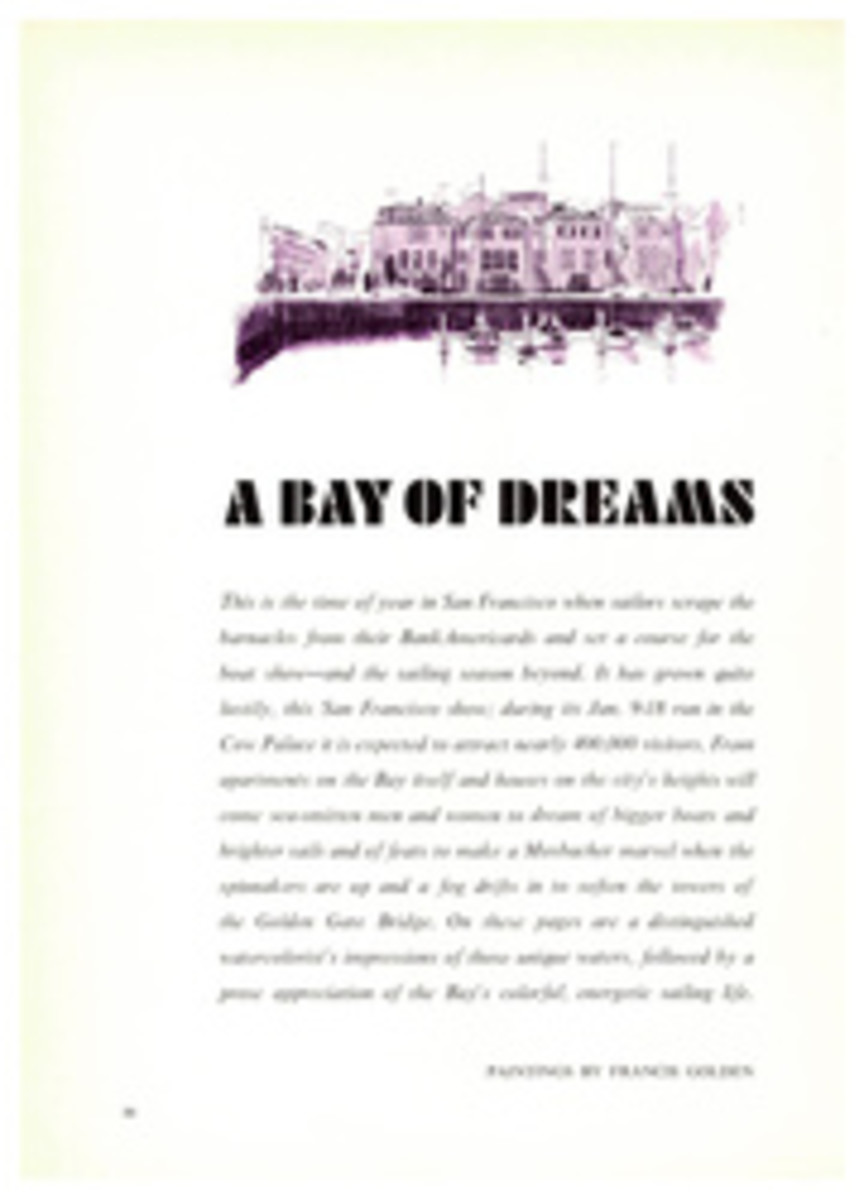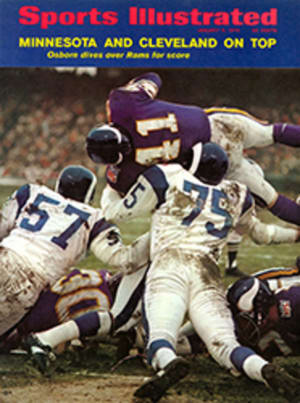
A BAY OF DREAMS
This is the time of year in San Francisco when sailors scrape the barnacles from their BankAmericards and set a course for the boat show—and the sailing season beyond. It has grown quite lustily, this San Francisco show; during its Jan. 9-18 run in the Cow Palace it is expected to attract nearly 400,000 visitors. From apartments on the Bay itself and houses on the city's heights will come sea-smitten men and women to dream of bigger boats and brighter sails and of feats to make a Mosbacher marvel when the spinnakers are up and a fog drifts in to soften the towers of the Golden Gate Bridge. On these pages are a distinguished watercolorist's impressions of those unique waters, followed by a prose appreciation of the Bay's colorful, energetic sailing life.
FRISKY WATERS BY AN ALABASTER CITY
As the rest of the world sometimes tires of being told, the people of San Francisco add a pinch of verve and a dash of ingenuity to life's little pleasures, yachting not excepted. When the sailing season opens for San Francisco on the first Sunday in May, it seems that everyone who owns anything floatable steers it for the grand rendezvous beneath the Golden Gate Bridge. There the pilot boat California waits to lead a parade back along the shoreline of the Bay, past Fort Scott, past the Presidio and the Palace of Fine Arts, past the Marina, past Gas-house Cove and Fort Mason and all the way to the toe of Telegraph Hill. There everyone disperses for rejuvenation and refreshments in the protected waters of a hundred coves and inlets. It is a marvelous celebration and yet an incongruous one—some might say it is better suited to a Sicilian fishing fleet than an admixture of American merchants, lawyers, bus drivers and other maritime addicts. The whistles blow, the fireworks pop and the balloons fly with an élan that is delightfully un-American.
There follow some 20 or 30 weekends of hectic racing and leisurely cruising in some of the friskiest, moodiest, busiest and most spectacular water to be found anywhere on the continent. From their nesting grounds in Sausalito and Tiburon and the Lower and Upper Bay, the boats emerge to challenge the stiff breezes funneling through the Golden Gate or to drift idly in the lee of Angel Island and Belvedere.
The San Francisco summer has a quality as unique as the shimmering city that rises out of the Bay like an alabaster mirage. For one thing, it is parka weather. The chill wind scudding across the Bay will blow up to 30 knots or more. When it meets an ebbing tide, the chop on the surface of the Bay calls for a brand of seamanship that only years of local knowledge can provide. Toward evening the furnace air of the Central Valley pushes its way into the Delta and the Bay beyond to confront the Pacific breezes. Then an opaline fog descends over Bay and city.
Astride the yacht anchorage of the city and facing the waterfront dwellings of the Marina, the St. Francis Yacht Club sits in isolated splendor. In the days when the bonanza kings raced their cumbersome gaff-rigged sloops through the Bay, the 100-year-old San Francisco YC lived in Sausalito, but it outgrew those quarters in 1927 and split. Half the San Francisco members opted for a new anchorage in nearby Belvedere, but 400 members put up $1,000 apiece and built themselves the present St. Francis Yacht Club adjoining the Marina on a landfill that was made for the 1915 Panama-Pacific Exposition.
Because yachtsmen are as near to a classless society as you are apt to get in San Francisco, the St. Francis YC is anything but stuffy. At noontime a number of the members drift over from their downtown offices for lunch in the grill room, and it is not unusual for one of them to be hammering out a little ragtime on the upright piano in the corner.
Looking out the windows of the St. Francis YC on a Saturday or Sunday morning during the season you can see such an assembly of sail it might seem possible to walk a few hundred yards across the Bay from boat deck to boat deck. Of the more than 30 classes of boats organized to race in the Bay, most will be represented in one way or another, but the local one-design classes such as the Bear and Cal boats will predominate. They are mainly sloop-riggers, sparse of sail and heavy of keel to better battle the winds and tides that make Bay sailing so demanding.
Then there are the more ecumenical types, boats seen on a variety of waters. What most of them have in common, however, is the versatility to both race and cruise. For the latter is indigenous to Bay yachting. Many of the races involve an overnight stop—for example, the traditional Vallejo race, part of which starts near the San Rafael Bridge, passes through San Pablo Bay and has its sleeper close by the old Mare Island Navy Yard. Others take to the open sea and anchor overnight at Drake's Bay to the north or Santa Cruz to the south. Or, if just a single day's racing is involved, they may circumnavigate the bleak Farallon Islands, 30 miles offshore, or the lightship a mere 11 miles west of the portals of the Golden Gate.
Unless one has sailed the Bay it is not easy to imagine the stunning effect of passing beneath one of those massive bridges, with their stanchions dwarfing you and your boat like colossuses from some forgotten fairy tale. Or of passing beneath the fantail of a merchant ship that suddenly materializes out of the fog with its cargo of mystery from a distant port. Or sailing abreast of an immense aircraft carrier with its thousand-foot homecoming pennant streaming aft and its solemn crew lining the rail and tasting the first sight of home. The day was when the big ships in the Bay served as moving hazards for the racing fleet and enterprising helmsmen used them like picks in a basketball game. That ceased when such games were ruled reason for disqualification.
Just as the great boat parade inaugurates each new season, the rather exclusive cruise of the St. Francis Yacht Club in September signals its impending demise. Craft of all shapes and sizes sail the 70 miles up the San Joaquin River to Tinsley Island, the club's 40-acre retreat a few miles west of Stockton. It is strictly stag, and there on Tinsley for two days and three nights some 600 yachtsmen loll and eat and drink and tell stories and watch amateur theatricals each evening after supper. It is known as the Bohemian Grove of yachting, and such eminent sailors as Bus Mosbacher and the Stephens brothers from New York, along with several dozen of their East Coast neighbors, often make the trip.
By early October the heat begins to subside in the Central Valley, the brisk westerlies off the Pacific die down, a more gentle wind comes out of the north and northeast, and the waters of the Bay lose much of their vigor. The minds of sailors turn to football and golf and duck shooting, and all but the most ardent of them lash down their boats for another winter.
TWO ILLUSTRATIONS
FRANCIS GOLDEN
ILLUSTRATION
FRANCIS GOLDEN
Racing yachts flying downwind in close company sail past one of the Bay's ubiquitous freighters.
TWO ILLUSTRATIONS
FRANCIS GOLDEN
Fog shrouds the shore as Bird class yachts depart the San Rafael Bridge (above) and run for Vallejo. Below, Knarr sloops have a spirited race.

